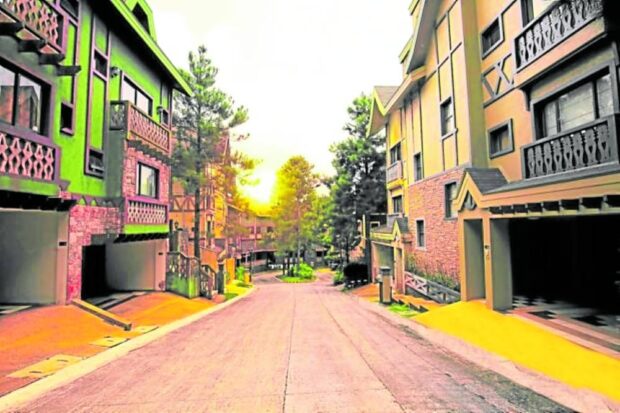Navigating the future of Philippine real estate

(HTTPS://WWW.LOBIENGROUP.COM)
Amid lingering risks and volatilities, what’s next for Philippine real estate?
While the industry admittedly still bears the scars of the pandemic, experts and observers have long asserted that the most tumultuous phase of this health and economic crisis is over—evident in the substantial strides so far made toward recovery.
For 2023 alone, Philippine property developers have been unveiling new projects, announcing even more aggressive expansions, partnerships with foreign firms, and increased capital spending, signaling that indeed lucrative opportunities and prospects continue to abound. They are all moving forward, mindful of the lessons learned over the last three years, but actively steering the industry toward new horizons.
Indeed, the strong, positive momentum amid the industry’s ongoing recovery brings a renewed sense of resilience and adaptability, with stakeholders now focusing on strategic initiatives to propel the sector forward.
There’s no illusion, though, that the industry is well out of the woods considering that there remain uncertainties and headwinds. Questions persist: How far along is the Philippine real estate sector in its recovery? Will 2024 mark the year when the industry can confidently declare its full recovery? What challenges and opportunities await stakeholders in the coming year? Which trends will continue to shape the industry in 2024?
Inquirer Property polled four of the country’s top real estate advisory firms to get their insights about the real state of the industry, their fearless forecasts for the year ahead, as well as their thoughts on growth prospects, trends, artificial intelligence (AI), property technology (proptech), sustainability, real estate investment trust (REIT), among others. Here’s what they have to say.
Maximizing opportunities amid continuing recovery
Joey Roi Bondoc
Colliers Philippines
We are definitely way past the black swan event that disrupted the property market in 2020 and 2021. Following a tumultuous two-year period, we started to see some recovery in the Philippine property market in 2022.

Colliers sees greater emphasis on healthy and sustainable office space.
In our view, it might take a few more years before we see the domestic real estate market reverting to pre-pandemic level of demand and supply. We still expect marginal rise in vacancy in office and secondary residential market in 2023. Developers remain cautious with launches as they temper the decline in demand, rise in land values, and increase in interest rates.
Investors, developers, and other stakeholders should meanwhile be mindful of global economic headwinds and geopolitical tensions that may affect supply chain and further elevate developers’ costs. These may disrupt the property sector’s recovery so stakeholders must start implementing strategies to future-proof their investments against potential disruptions post-2023.
Tailwinds persist
What’s positive is that tailwinds persist and developers should maximize opportunities, including the fact that the Philippines, with its consumption-led growth, is one of the fastest growing economies in Asia. Add to that the ramped up government spending, due mainly to the public sector’s goal of pump-priming the economy and bolstering the country’s infrastructure backbone, which should also benefit the Philippine property sector.
Colliers is optimistic that the gradual rebound of the country’s economy will have a positive effect on the country’s property segments, especially hotel and retail. While the industrial sector will continue to be weighed down by rising interest rates, expansion remains on the horizon especially once the pledged foreign investments start to flow into the country.
Healthy offices
Next year, we see greater emphasis on healthy and sustainable office space, including those with WELL, Leadership in Energy and Environmental Design (LEED), EDGE, and Building for Ecologically Responsive Design Excellence (BERDE) certifications.
Colliers believes that the future of office buildings leans toward developing spaces that are safer, healthier and less harmful to the environment. Colliers has also observed that some discerning occupiers prefer or require ESG [environment, social and governance] certified office space.
In the first nine months of 2023, about 32 percent of the transactions were in LEED-certified buildings. From 2024 to 2026, an estimated 47 percent of new office towers will have certifications.
Sustained demand
Colliers also sees sustained demand for office space outside Metro Manila.
In the first nine months, Colliers recorded 149,500 sqm of provincial transactions, up from 145,000 sqm a year ago. Developers must complete delivery schedules of their projects as we observed increasing inquiries from outsourcing firms in Iloilo, Bacolod, Bulacan, and Laguna.
We likewise encourage developers to be on the lookout for potential demand in key cities such as Iligan, Dagupan, Urdaneta, Malolos, General Santos, Tarlac, Cabanatuan and Puerto Princesa as these locations are touted as high potential areas for transformation into “digital cities” by 2025 according to IT and Business Process Association of the Philippines (IBPAP).
Leisure themed projects
For the residential market, Colliers sees the expansion of resort or leisure-themed projects outside Metro Manila, and we project the launch of similar projects as property firms cater to a rising demand from a discerning and affluent market.
We also see more value-added features integrated into new residential launches. Developers should consider integrating green features such as occupancy sensors, LED lights, optimized air quality and provisions for solar panels and rainwater harvesting systems, and explore securing green building certifications to stand out among newly-launched projects.
Improving demand
In retail, mall operators should maximize consumers’ willingness to visit brick-and-mortar spaces by curating events like wedding fairs, bazaars, and housing summits; capture rising demand from foreign retailers planning to enter the country; and use their renovation or expansion projects as an opportunity to expand food and beverage (F&B) tenants.
In our view, mall operators and retailers should be more innovative with the use of their spaces to sustain footfall especially as the impact of revenge spending across the country is starting to dissipate.
Strong rebound
Hotel developers and operators meanwhile should assess future demand for meetings, incentives, conferences and exhibitions (MICE) facilities given the segment’s potential for a strong rebound. This will partly boost the arrival of international tourists and business travelers as well.
Developers need to plan their expansions and carefully assess whether to launch or expand their own homegrown brands or partner with foreign hotel operators. Colliers data show that about 42 percent of new hotels that will open in Metro Manila from 2023 to 2024 are foreign brands. They should also check opportunities to build more accommodation facilities in key destinations including Pampanga, Cebu, Bohol, Davao, Palawan and Bacolod.
Competitiveness as a manufacturing hub
Industrial parks in central and southern Luzon will continue to entice investors and the continued expansion of developers’ industrial footprint should boost the Philippines’ competitiveness as a manufacturing hub in Asia.
Colliers believes that the completion of about 560 ha of industrial space in southern and central Luzon from 2023 to 2025 should provide more options for potential manufacturing and logistics locators and allow them to haggle for more attractive land and warehouse lease rates.
AI, sustainability, and real estate
To a certain degree, artificial intelligence (AI) will help modernize the developers’ offerings—from virtual tours to enhanced designs of projects. More home appliances will also likely be powered with AI technologies, further elevating residents’ quality of life.
Meanwhile, integrating sustainable features is crucial if developers want to further differentiate in a sector becoming more “sustainable” by the day. The results of an informal survey conducted by Colliers Philippines showed that more than 90 percent of investors find these sustainable features important in any residential investment.
Moving forward, we only see AI technologies and sustainability features further revolutionizing property developments in the Philippines. At the same time however, developers should continue innovating as we project further evolution of product offerings in Philippine real estate.
Growth prospects remain despite headwinds
Claro dG. Cordero Jr.
Cushman & Wakefield
Next year will be a pivotal year for Philippine property as the various subsectors undergo major structural shifts defining its long-term movement.
The recent pandemic and the current economic headwinds are driving these shifts in utilizing office, residential, retail, hospitality, as well as logistics and industrial developments.
The lingering global economic slowdown, along with the geopolitical conflicts in Eastern Europe, the Middle East and the West Philippine Sea regions, will eventually weigh down on prospects in the local property market despite resilient macroeconomic fundamentals. It is highly likely that the lagged effects of inflation and resulting interest rate adjustments will be more evident in the short-term.
Slower recovery of consumer spending is meanwhile expected to set in as consumers begin to be more conservative due to escalating prices, while shying away from credit due to sudden hike in borrowing rates.
Growth prospects
Despite these, growth prospects remain in select segments of the market.
Demand for luxury and high-end developments remain unaffected and will continue to thrive. As a result, high quality developments across all property subsectors will continue to exhibit strong asset values and higher rental rates.
Property values and rents in the mid-end segment will meanwhile exhibit moderate growth due to the balance of returned or vacated developments and the completion of more supply.
High quality and prime developments will continue to be in-demand while lower quality developments will require higher capital expenditure to attract tenants or buyers. The low-end segment of the commercial sub-sector is affected by obsolescence and will be faced with even more challenges, as financing becomes more scarce, amid increasing yield rates.
C&W Research further estimates that net space absorption in office submarket in 2024 will nearly double the estimated net absorption in 2023. But this will still be significantly lower than the average net absorption seen prior to the pandemic. The advent of flexible/hybrid work practices will also continue to encourage the growth of communities and developments in the immediate peripheries of urban centers, adding more options for occupiers outside the central business district (CBD).
Flight to quality
With hybrid or flexible work practices gaining further traction and with the implementation of the revised guidelines of the Telecommuting Act (R.A. No. 11165), future real estate strategies and demand of major corporate occupiers are likely to evolve at a faster rate in 2024.
The return-to-office efforts will intensify the flight-to-quality developments in order to attract back the workers. Global corporate occupiers are increasingly looking for more spaces allotted for improved amenity sets dedicated to workers: gyms with staff or attendants, coffee bars with baristas on duty, cocktail bars, dining facilities, staffed co-working facilities, and high-end meeting rooms.
Promising advancements
Advancements in AI, including generative AI, are showing promise in the real estate industry.
For one, AI is starting to enhance the property search and analysis process. The availability of proptech (coined to mean property and technology) reshapes how real estate investors analyze potential investment opportunities, improves customer experience and client delivery, helps streamline due diligence and improves fraud detection in real estate transactions.
Although AI has been used in real estate for years, many of its capabilities and functionality are still largely untapped. This highlights the lack of proper information. Misinformation is a key barrier to adoption. The current need is for more secure and well-planned digital transformations to enable future investment decisions to harness the full spectrum of emerging technologies and set a new standard for corporate real estate insights.
Altered market demand
Given the old market and related risks, and the dawn of new challenges in adapting to the altered market demand, it may still take some time before we can safely proclaim that we have already achieved full recovery.
The Philippine property market plane has shifted and the altered market demand requires new practices and technologies to service them.
The ongoing structural shift has shifted the focus on high quality developments that support this new demand. But this also puts undue pressure for the greater majority on what is available in the local market that does not answer to this and may have to wait for the tide until the investment environment turns more favorable for capital recycling and asset repurposing.
Still on a growth path to recovery
David Leechiu
Leechiu Property Consultants
We anticipate the real estate sector maintaining its upward growth trajectory in 2024.
In the office market, we expect leasing demand to surpass last year’s figures, due to increased take-up by the IT and business process management (IT-BPM) sector despite the adoption of hybrid work arrangements. The anticipated decline in pipeline supply next year should also help reduce overall vacancy rates, complementing the current live demand requirements projected for 2024, thus aiding in market recovery.

Major developers allocate resources towards expanding their leisure and resort portfolios.
Regarding the residential market, demand is poised to continue its growth, partly due to the robust employment in the IT-BPM industry. The limited introduction of units into the market indicates potential for improved take-up rates in residential developments the following year.
Simultaneously, the tourism sector is witnessing heightened interest, as major developers allocate resources towards expanding their leisure and resort portfolios in renowned beach destinations and areas with either ongoing or completed international airports.
Nevertheless, we remain vigilant regarding ongoing geopolitical risks that could potentially hinder investment inflows. Stakeholders are closely monitoring interest rates, inflation, and logistical concerns on the supply side throughout 2024.
Opportunities in tourism, residential
The two sectors that will drive growth prospects next year are tourism and residential.
With improved connectivity and accessibility, the country’s top tourism destinations will continue to attract visitors, pushing developers to deploy their efforts towards building more leisure projects.
For the residential sector, opportunity lies in the significant housing backlog the country has accumulated over the years. Coupled with increasing affluence due to the growth of the service sector and, demographically, the high birth rate, the housing demand will continue to be unmet.
We have a real estate sector that can only produce a maximum of 200,000 units a year, amid a backlog of 6.5 million homes—a backlog growing annually and which the government targets to address with its goal of completing 1 million units per year until 2028.
Digital transformation, flexibility, experience
Among the current trends in real estate include digitalization and digital transformation; flexibility in terms of space and people; human experience or experiential space; and smart home technologies.
For digitalization and digital transformation, it’s about data exchange and transparency. The Philippine market is still opaque, and the passing of the Valuation Reform Act will give more stakeholders access to more reliable information, which will aid them in their decision-making.
There is potential for transparency to improve with digitalization. With more reliable data available to stakeholders, they will be able to make more informed real estate strategies.
For flexibility in terms of space, we believe there will be more certainty regarding work arrangements by 2024. In terms of people, reskilling and upskilling are integral for companies to adapt to the dynamic era of automation and AI. Even if some positions eventually become obsolete, new roles will be created and new needs will emerge. Next year, we will start to see and recognize these new roles that will be created.
Human experience or experiential space will drive the transformation of existing spaces to promote a more interactive experience, whereas smart home technologies will continue to gain traction, especially those that are now considered basic in other countries.
Remaining competitive
As more corporates aspire for net zero, developers will need to adopt green building technologies to remain competitive.
We also see major financing institutions and banks with available lending windows highlighting sustainability. With that, more real estate projects will start to adopt these principles to avail of such funding. Environmental, social, and corporate governance (ESG), as well as diversity, equity, and inclusion (DEI) practices of large banks are seen to have a major influence in where, what, and to whom such funds are released.
It’s a similar story for the burgeoning green investing movement, wherein sustainable initiatives are supported by funding. Developers will be encouraged to include ESG-oriented practices in their projects to attract green investments.
Recovery stage
However, we’re not out of the woods yet. We’re still in the recovery stage from the pandemic.
Office will surpass 2022 numbers this year with locators taking up space even with hybrid work arrangements, while residential home sales are already at 90 percent of pre-pandemic levels. However, with the low supply numbers might not be able to meet demand in 2024. Meanwhile, tourist arrivals are only at around 4.8 million visitors per year—this is just a little more than half of the peak of tourist arrivals of 8 million per year prior to the pandemic.
But with the heavy mobilization of infrastructure projects and adoption of current trends in property development, the real estate industry is still on a growth path to recovery.
Strong performance seen in 2024
Sheila Lobien
Lobien Realty Group
Lobien Realty Group sees the real estate sector continuing its recovery trajectory in 2024.
For the Metro Manila office space segment, annual demand will reach 400,000 sqm while new supply will be at about 500,000 sqm, resulting in vacancy rates easing to less than 15 percent. Average rental rates, however, are seen staying in the P1,100-per-sqm level.
The BPO industry will continue to be the main demand driver while back-to-work mandates will prompt companies to secure spaces with better deals. Industrial real estate will maintain its compounded annual growth rate of 5 percent to 7 percent, while townships will prop the residential and commercial office spaces. Tourist arrivals, projected to breach 7 million in 2024, will accelerate the hospitality segment’s recovery in terms of room and occupancy rates.
Growth streak
Industrial real estate, including warehouse and storage, is poised to sustain its upward trajectory, fueled by the anticipated 20 percent growth in e-commerce. The sector is expected to reach approximately P700 billion in revenue next year.
The hotel sector will also post another good recovery owing to expectations that tourist arrivals will grow by 40 percent to 7 million in 2024. Townships will likewise drive residential/condominium growth as more discerning investors, including overseas Filipino workers (OFWs), are beginning to find merit in investing in real estate, particularly those situated in integrated mixed-use developments. OFW remittances in 2023 is expected to hit $37 billion which will possibly increase to $39 billion in 2024.
Good investment avenue
Real estate investment trusts (REITs) will continue to be a good investment avenue for real estate players. Once inflation becomes within range and the interest rates tightening is reversed, REIT prices are seen to recover. For this year, it is expected that REIT dividends will grow 5 percent year-on-year—which is good news for REIT investors.
Township residential/condominium units will also continue to be the trend as a result of its functional value being realized during the pandemic as well as its resilience in price fluctuations. However, based on the 2023 Bangko Sentral ng Pilipinas real estate data, loans for single detached homes rose by almost 50 percent, a trend that may continue because of the need for more space by families—something that became more pronounced during the pandemic.
Meanwhile, the growth in warehouse and storage will continue by necessity, as the financial markets support more digitalization of purchase transactions.
Adopting advanced technologies
The impact of proptech and AI in real estate is not yet significant at the moment, except for the use of the internet and digitalization of certain aspects of the real estate processes, including brokerage services.
However, as AI becomes more powerful, the real estate industry has to adopt new technologies, adapt to the challenges it will present, tap the opportunities it will offer, and embrace its value in facilitating real estate transactions.
Strong performance
The challenges being faced by the country’s real estate industry are now remotely related to the pandemic. These are now more economic in nature, chief of them would be the current high interest rates which is the government’s logical response to elevated inflation.
The higher interest and inflation rates have negatively impacted real estate investments, decisions, as well as actual construction and take-up. With the Russia-Ukraine conflict and the prevailing supply chain issues now factored in economically, the inflation being within target of 2 percent to 4 percent next year, and an expected GDP of 6 percent in 2024, the real estate industry is poised for a strong performance in 2024.




